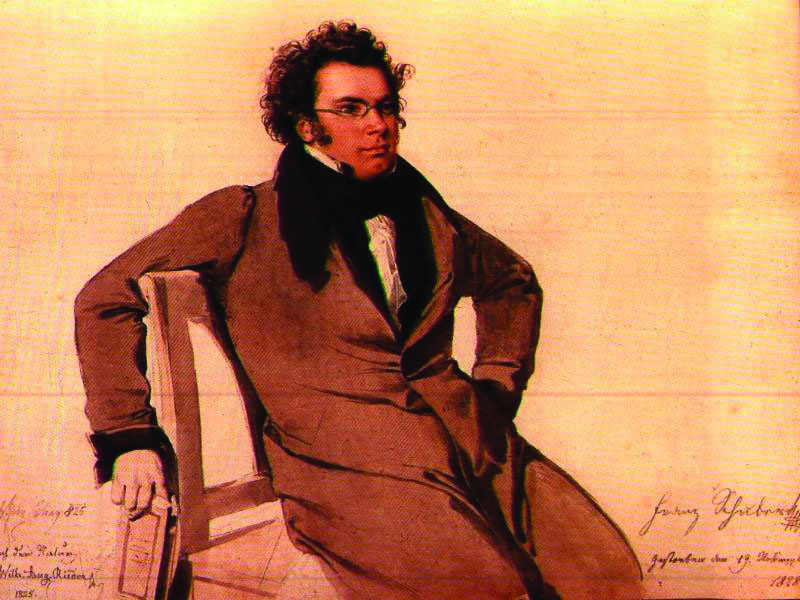SONATA IN A MAJOR, FOR ARPEGGIONE AND PIANO, D. 821
Franz Schubert
(b. Vienna, Austria, January 31, 1797; d. Vienna, November 19, 1828)
Composed 1824; 26 minutes
 Shaped like a guitar and sharing its six strings, frets and tuning, but held between the knees and bowed like a cello, the arpeggione had few champions. Two years after it was introduced in 1823, Vincenz Schuster, Viennese guitarist turned arpeggione player, optimistically wrote a manual. Finding no substantial repertoire to play on his new instrument, Schuster asked Schubert for a work to display his virtuosity. Both were regulars in the musical gatherings at law professor Ignaz Sonnleithner’s home in Vienna, and likely met there. Schubert completed his sonata in November 1824, but interest in the new instrument rapidly waned and it did not find other advocates. Several instruments survive in collections to this day and, from time to time, attempts are made to revive interest in the arpeggione. But, when Schubert’s sonata was eventually published almost half a century after the composer’s death, it was issued with an alternative part for cello – and that is the way the Arpeggione Sonata is most often performed (and how it will be performed today). Freer transcriptions have been made for viola, violin, flute, clarinet and even euphonium. Gaspar Cassadó used to perform it as a cello concerto in the middle of the last century.
Shaped like a guitar and sharing its six strings, frets and tuning, but held between the knees and bowed like a cello, the arpeggione had few champions. Two years after it was introduced in 1823, Vincenz Schuster, Viennese guitarist turned arpeggione player, optimistically wrote a manual. Finding no substantial repertoire to play on his new instrument, Schuster asked Schubert for a work to display his virtuosity. Both were regulars in the musical gatherings at law professor Ignaz Sonnleithner’s home in Vienna, and likely met there. Schubert completed his sonata in November 1824, but interest in the new instrument rapidly waned and it did not find other advocates. Several instruments survive in collections to this day and, from time to time, attempts are made to revive interest in the arpeggione. But, when Schubert’s sonata was eventually published almost half a century after the composer’s death, it was issued with an alternative part for cello – and that is the way the Arpeggione Sonata is most often performed (and how it will be performed today). Freer transcriptions have been made for viola, violin, flute, clarinet and even euphonium. Gaspar Cassadó used to perform it as a cello concerto in the middle of the last century.
.jpg) Apart from several strummed and bowed chords, Schubert requires little from the arpeggione that the cello or the viola cannot provide. Since the top string of the cello is tuned a fifth lower than that of the arpeggione, however, the opening movement calls for agile fingerwork high on the A-string and many wide leaps. Virtuoso display is not the goal though; there’s a fragility and intimacy to the music. Schubert focuses on lyrical writing, contrasting his wistful main theme with a busier, more assertive second theme. The Adagio introduces an eloquent, sustained melody over gently pulsing piano chords, a melody that would be quite at home in one of Schubert’s songs. It leads, via a short rhapsodic passage, to a genial finale
Apart from several strummed and bowed chords, Schubert requires little from the arpeggione that the cello or the viola cannot provide. Since the top string of the cello is tuned a fifth lower than that of the arpeggione, however, the opening movement calls for agile fingerwork high on the A-string and many wide leaps. Virtuoso display is not the goal though; there’s a fragility and intimacy to the music. Schubert focuses on lyrical writing, contrasting his wistful main theme with a busier, more assertive second theme. The Adagio introduces an eloquent, sustained melody over gently pulsing piano chords, a melody that would be quite at home in one of Schubert’s songs. It leads, via a short rhapsodic passage, to a genial finale